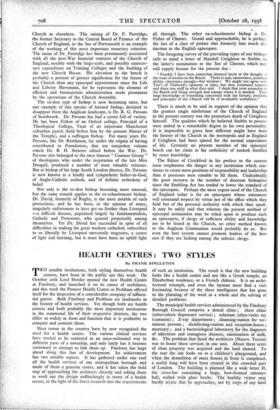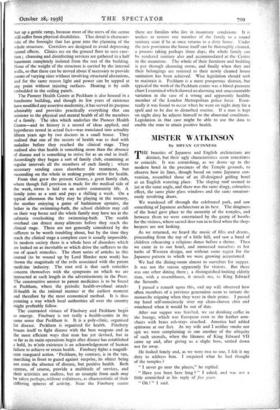HEALTH CENTRES : TWO STYLES
By FRANK SINGLETON
Most towns in the country have by now recognised the need for a health centre. The various clinical services have tended to be scattered in an unco-ordinated way in different parts of a township, and only lately has it become customary to attempt to link them up. Finsbury has leapt ahead along this line of development. Its achievement has two notable aspects. It has gathered under one roof all the health services of one metropolitan borough and made of them a genuine centre, and it has taken the bold step of approaching the architects directly and asking them to work out the design unflinchingly in terms of a health centre, in the light of the latest research into the requirements of such an institution. The result is that the new building looks like a health centre and not like a Greek temple, an Elizabethan residence, or a French château. It is an archi- tectural triumph, and even the layman must find a visit fascinating because of the sheer intelligence that has gone to the planning of the work as a whole and the solving of detailed problems.
The municipal health services administered by the Finsbury Borough Council comprise a dental clinic ; chest clinic (tuberculosis dispensary service) ; solarium (ultra-violet ray treatment) ; X-ray department ; cleansing-station for ver- minous persons ; disinfecting-station and reception-house ; mortuary ; and a bacteriological laboratory for the diagnosis of infectious and contagious diseases, examination of milk, &c. The problem that faced the architects (Messrs. Tecton) was to house these services in one unit. About three acres of slum property was acquired and the land cleared. To the rear the site looks on to a children's playground, and when the demolition of more houses in front is completed, a useful lung will have been created in this crowded part of London. The building is planned like a wide letter H, the cross-bar containing a large, bow-fronted entrance hall, walled with glass bricks. The healthy visitor may hardly notice that he approaches, not by steps of any kind but up a gentle ramp, because most of the users of the centre will suffer from-physical disabilities, That detail is character- istic of the foresight that has gone into the planning of the whole structure. Corridors are designed. to avoid depressing tunnel effects. Clinics are on the ground floor to save exer- tion;: cleansing and disinfecting services are gathered in a half basement completely isolated from the rest of the building. None of the weight of the structure is carried by the internal walls, so that these can be moved about if necessary to provide rooms of varying sizes without involving structural alterations, and for the same reason light and power can be tapped at any point without injuring surfaces. Heating is by coils embedded in the ceiling panels.
The Pioneer Health Centre at Peckham is also housed in a handsome building, and though its few years of existence have modified any assertive modernity, it has served its purpose admirably and provides practically everything • that can minister to the physical and mental health of all the members of a family. The idea Which Underliet the Pioneer Health Centre—and its history is a record of ideas applied, and hypotheses tested in actual fact—was translated into actuality fifteen years ago -by two doctors in a small house. They realised that one of the secrets of health was to deal with maladies before they reached the clinical stage. They realised also that health is something more than the absence of disease and is something to strive for as an end in- itself. Accordingly they began a sort of family club, examining at regular intervals all the members of each family ; where necessary sending cases elsewhere for treatment, but succeeding on the whole in making people strive for health.
From that grew the present Centre, a great family club, where though full provision is made for the medical side of the work, stress is laid on an active community life. A family - joins as a unit - and pays a shilling a week. On a typical afternoon the baby may be playing in the nursery, the mother enjoying a game of badminton upstairs, the father in the swimming-bath; the _school children' may call on their way home and the whole family may have tea at the . cafeteria overlooking the swimming-bath. The nealth overhaul can detect many ailments before they reach the clinical stage. These are not generally considered by the sufferers to be worth troubling about, but by the time they reach the clinical stage a complete cure is usually impossible. In modern society there is a whole host of disorders which are looked on as inevitable or which drive the sufferers to the use of quack remedies. The short series of articles in this journal (to be wound up by Lord Horder next week) has shown the magnitude of the evils associated with the patent medicine industry. The root evil is that such remedies concern themselves with the symptoms on which we are instructed at such length in the advertisements in the Press. The constructive answer to patent medicines is to be found at Peckham, where the periodic health-overhaul attacks ill-health in the rational manner' at the earliest moment and therefore by the most economical method. It is thus pointing a way which local authorities all over the country might profitably follow.
The- contrasted virtues of Finsbury and Peckham' begin to emerge. Finsbury is not really a health-centre in the same sense that Peckham is. It is a poly-clinic, organised for disease. Peckham is organised for health. Finsbury braces itself to fight disease with the best weapons and in the most efficient 'ways that man has yet devised, but in so far as its main operations begin after disease has established a hold, its Whole existence is an acknowledgement of human failure to achieve or 'retain health. Finsbury fights a magnifi- cent rearguard action. °Peckham, by contrast, is in the van, Marching in front to guard against surprise, its object being not even the absence of disease, but positive health. Both centres,, of course, provide a multitude of services, and their activities are endless, but an example from each may be taken perhaps, without unfairness, as characteristiC of their differing spheres of activity. Near the Finsbury centre there are families who live in insanitary conditions. It is useless to restore one member of the family to a sound sanitary state if he at once returns to a dirty home. Under the new provisions the house itself can be thoroughly cleaned, a process taking perhaps three days, the whole family can be rendered sanitary also and accommodated at the Centre in the meantime. The whole of their furniture and bedding is put. through cleansing ovens, and finally when they and their belongings are restored to their newly cleaned house sanitation has been achieved. Wise legislation should seek to maintain it. Peckham is a more prosperous district, but typical of the work of the Peckham centre was a blood-pressure chart I examined which showed an alarming and unaccountable variation in the case of a strong and apparently healthy member of the London Metropolitan police force. Even- tually it was found to occur when he went on night duty for a spell and to be due to disturbed routine. If a man is kept on night duty he adjusts himself to the abnormal conditions. Legislation in that case might be able to use the data to enable the man to attain positive health.

























































 Previous page
Previous page